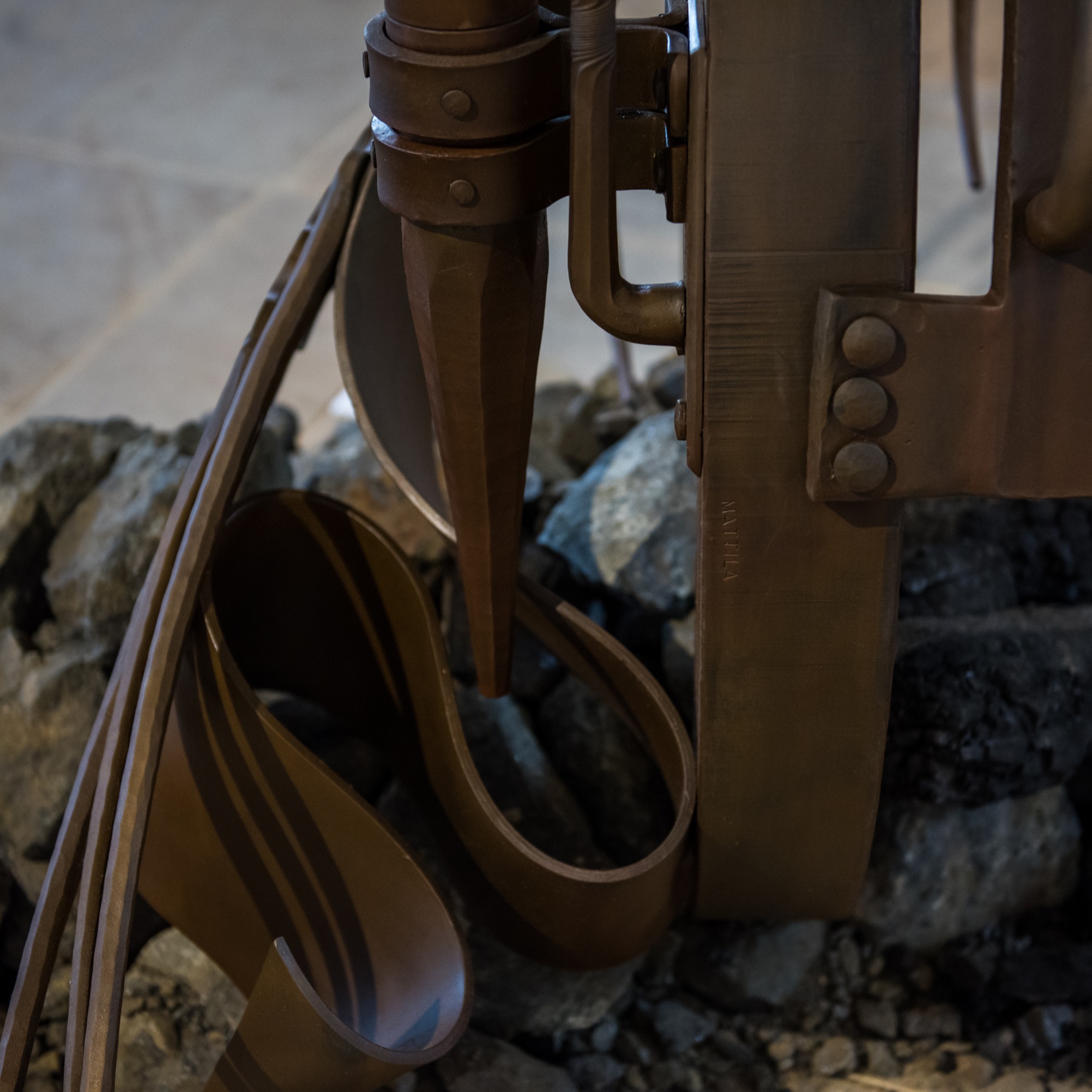Design Tasmania
Corner of Brisbane and Tamar streets
Launceston, 7250
Tasmania
info@designtasmania.com.au
+61 3 6331 5506

Catalysis
15 January - 3 March 2019
Design Tasmania is proud to present Catalysis an exhibition of works by Tasmanian based sculptor, blacksmith and designer Pete Matilla.
Image Credit: Emily Dimozantos 2019.
Speeding Up Deep Time
Catalysis is the acceleration of a chemical reaction by a catalyst
Within this project the catalysis is the human engineered acceleration of deep time. These works provide a window into a geological event, reformatting ingredients to bring about change. The combination of carbon and iron ore creates steel. Iron has been the major driver for human tool making since the first manipulation of meteorites into tools. Iron sleeps in the mountains while Carbon (the sixth most abundant element in the universe known to us through charcoal), is the keystone element of 95 percent of all known compounds. Carbon is LIFE even after death. It is stored energy and the ultimate bonding agent of elements.
Catalysis explores the possibilities of combining fossicked elements from the Tasmanian environment, alongside post-industrial materials. Magnetite from Savage River and charcoal from the burnt Weld Valley forest are reimagined, with industrial steel into sculptural form. These experiments begin to explore the physical reality of a full transformative process opening the conflicting conversation of industrial mining and forestry operations. The practice speaks of material histories, elemental histories, and the future of the object at hand. Forging metal or stone is like the speeding up of deep time - geomorphological processes influenced by the human hand. This is a potent allegory for the ‘contested’ epoch of the Anthropocene (this epoch argues that humans have influenced the environment, generating ecological and atmospheric change at a global scale). Catalysis explores the creative process of steel making from stone in this industrial age. These steel sculptures are the repercussions of intuitive motions within the studio. Each work has a ‘time capsule’ attached, these containers hold specific ingredients, elements and remnants of place.
Image Credit: Emily Dimozantos 2019.

The Forest Fused Into Stone
A handmade furnace fuelled only by charcoal from the state logged Weld Valley forest (forestry clear-fell then burn the remaining ecology) is slowly charged with magnetite from the Savage river and fanned to generate an incubation of 1,700 degrees. Over six hours the carbon molecule and iron molecule unite creating what is called a ‘Bloom’ of steel. The carbon content has to be just right. This bloom is essentially the forest fused into stone. This material is worked in its entirety or mixed with fossicked metals constituting the substance of the blades featured in Catalysis. Place is transformed into an heirloom. In two blades the bloom is fused with other elements creating a new alloy. These ingredients include meteorite shavings gifted by a master knife maker, as well as remnants from damaged and disturbed sites collected on journeys traversing Tasmania. These include a discarded chain found in a logging coupe, a fragment of wrought iron from a forgotten colonial graveyard, the spring from a torched joy ride car and bolts from the iron blow mine in Queenstown.
Many of these materials reference the extractive processes of colonial relations toward the environment as being a resource. Reclaiming and transforming these materials shifts the intended function from industrial employment to intimate tools. Their intended use can create sustenance, referencing the age-old adage of ‘turning swords into plowshares’.
Image Credit: Emily Dimozantos 2019.

Acknowledgements
"I would like to acknowledge and pay respect to the traditional owners of the land on which I live and work, the island of Trowunna, Tasmania. Specifically acknowledging indigenous custodians Rodney Dillon, Lee Prouse and Josh Prouse for their guidance, generosity and support with navigating a respectful path working with country."
"Many thanks go to the following individuals and organisations for their generous support and camaraderie: Selena de Carvalho, Ben Beames, Ken Morrision, Gus Smith, Mark Goodall, Rodney Dillion, Liberty Steel, Professor Vadim [Dima] Kamenetsky, Taig Simms, Larissa Kemp, Laura McCusker, Natalie Holtsbaum, Simon Himson, Mark Totham, Wayne Hudson and Karina Clarke."
"Thanks to all the Design Tasmania staff for their backing throughout the development and realisation of the project and MONA FOMA for including the work in their festivities."
"Grateful acknowledgement goes to Arts Tasmania for their assistance with the development and delivery of this project." -Pete Mattila
Image Credit: Emily Dimozantos 2019.
